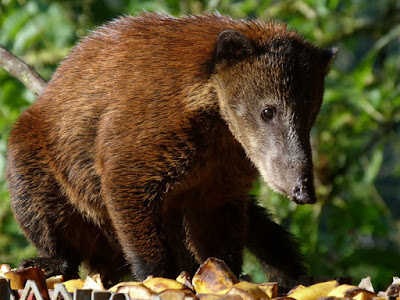In my last post I started a new thread in my irregular series on colours in nature, by featuring birds with 'rufous' or 'chestnut' in their names; I wonder if you were as surprised as I was how many there were? These rusty/gingery tones are widespread in animals, and are the result of reddish phaeomelanins combined with brown or black eumelanins. As I mentioned last time, we seem to have gone to more trouble with being precise about the colour with birds than we have with mammals, where we often just use 'Red' as a descriptor, though (or perhaps because?) very few mammals sport actual red tones.
 |
| Red-necked Wallabies Macropus rufogriseus, Namadgi National Park, Australian Capital Territory. A common medium-sized wallaby in near coastal eastern Australia. |
 |
| Red-tailed Squirrel Sciurus granatensis, Alanbi Lodge, north-western Ecuador. |
Think too of Red Deer and Red Fox, not to mention 'red'-headed humans. However many other mammals share such hues, sometime overall, sometimes as highlights, without using 'red' (or any other colour word) in their name. Primates feature quite strongly, from both Old and New Worlds, though other major groups are also well-represented. I've left out Orangutans here because I included them in the Orange posting, but they're one of those many borderline cases.
 |
| Proboscis Monkey Nasalis larvatus, Sarawak (above and below). This gorgeously pigmented monkey, the only one of its genus, is endemic to Borneo. |
 |
| Patas Monkey Erythrocebus patas, Waza NP, northern Cameroon. Another single-species genus, found across arid west Africa. |
 |
| Coppery Titi Monkey Callicebus cupreus, Tambopata Reserve, Peruvian Amazon. Just three members of this widespread neotropical genus were recognised until recently - now there are 16. |
 |
| Ecuadorian Squirrel Monkey Saimiri macrodon, Yasuní NP, Ecuadorian Amazon. (I think that expression is concentration rather than a lack of enjoyment.) |
Few bats are as strikingly rusty as the Little Red Fruit Bats above, but others have nice coppery highlights.
 |
| Short-nosed Fruit Bat Cynopterus brachyotis Nanga Sumpa Lodge Sarawak. These tiny fruit bats are common in rural buildings and under eaves in northern Borneo. |
 |
| Black Fruit Bats Pteropus alecto, Charters Towers, Queensland. This is a big fruit bat, found across northern Australia and into New Guinea and Indonesia. |
 |
| Grey-headed Fruit Bat Pteropus poliocephalus, Sydney Botanic Gardens. |
Among non-kangaroo marsupials, the most beautifully rusty has to be the lovely Numbat Myrmecobius fasciatus, once found across Australia but reduced - mostly by fox and cat predation it would seem - to pockets in south-western Australia, where once-promising reintroduction efforts seem to be faltering for reasons uncertain.
 |
| Numbat, Perth Zoo. (I have old slides from Dryandra Forest, but they really are not worth showing here!) |
Some antelope certainly meet our criteria for inclusion.
 |
| Bushbuck female Tragelaphus sylvaticus, Kruger NP, South Africa. |
 |
| Impala Aepyceros melampus, Lake Mburo NP, Uganda. |
 |
| Female and young African Buffaloes Syncerus caffer, can be quite rusty in colour (when not covered in mud) unlike the very dark bulls. (The Little Egret and African Skimmer are bonuses.) |
And some carnivores are also handsomely rusty. But I still can't decide if tigers are just rusty or outright orange!
 |
| Sumatran Tiger Panthera tigris sumatrae, Adelaide Zoo. |
 |
| South American Coati Nasua nasua, Umbrellabird Lodge, southern Ecuador. This beauty is undeniably rusty, but other individuals can be quite grey. |
Which is about all I've got for you today, but I'll be back soon with an offering of gingery-looking invertebrates and reptiles. There is also another posting on rusty birds to come, but by then I'll be back from Borneo, and we might have a change of topic before returning to them.
BACK ON MONDAY 23 MAY






No comments:
Post a Comment